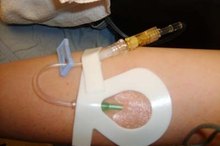What Are Nursing Interventions for GI Bleeding?
Gastrointestinal bleeding may occur anywhere along the digestive tract and it could be caused by gastric or duodenal ulcers, esophageal varices, diverticular disease, ulcerative colitis, Crohn's disease or injury. Some possible symptoms of gastrointestinal bleeding are a drop in blood pressure, coughing up blood, coffee ground vomit, black tarry stool, bright red blood in the stool and weakness. A nursing intervention is any nursing activity a nurse does to help a patient get better or feel more comfortable. There are several nursing interventions for a patient with a GI or gastrointestinal bleed.
Assessment
In order to determine what kind of nursing intervention a patient with GI bleeding needs, the nurse needs to gather information about the GI bleed. The nurse would also assess the effect of the GI bleed on the patient.
To assess for signs of a GI bleed, the nurse observes the patients stool and vomit for signs of blood. Assessing a patient's blood pressure, urine output and heart rate may be significant in checking for the extent of blood loss. A drop in blood pressure and urine output plus an increase in heart rate may indicate significant blood loss. After this, the nurse reports any significant findings to a physician.
- In order to determine what kind of nursing intervention a patient with GI bleeding needs, the nurse needs to gather information about the GI bleed.
- To assess for signs of a GI bleed, the nurse observes the patients stool and vomit for signs of blood.
Assist With Diagnostic Procedures
Kidney Stent Side Effects
Learn More
A physician may decide to perform diagnostic procedures that will help determine the exact site of the GI bleed. Such procedures may include an endoscopy, colonoscopy, sigmoidoscopy or barium studies. "Nursing care Plans: Nursing Diagnosis and Intervention," by Meg Gulanick suggests that a nursing intervention in this case would be for the nurse to assist the physician directly or ensure that these procedures, if required, are done as and when needed 2.
Administer Fluids and Other Treatments.
Administration of blood, blood products, fluids, electrolytes, vitamins and other medications may be prescribed by a physician. Here, a nursing intervention would be to administer all prescribed treatments as ordered by the physician. This nursing intervention helps replace the blood lost by a patient, prevent further loss or address the effects of blood loss such as anemia. Additionally, the nurse has to ensure that the patient with a GI bleed is not given medications that could cause further bleeding.
- Administration of blood, blood products, fluids, electrolytes, vitamins and other medications may be prescribed by a physician.
- This nursing intervention helps replace the blood lost by a patient, prevent further loss or address the effects of blood loss such as anemia.
Evaluation
What Is a Heparin Lock?
Learn More
To find out if any nursing intervention done for a patient with a GI bleed has been successful, the nurse has to re-assess the patient after all the interventions have been done. Reassessment includes checking vital signs such as blood pressure and inspecting the patient's stool and vomit. The nursing interventions are successful when the patients blood pressure, heart rate and urine output have returned to normal. Also, absence of blood in a patients vomit or stool may be an indication that the nursing interventions were successful.
- To find out if any nursing intervention done for a patient with a GI bleed has been successful, the nurse has to re-assess the patient after all the interventions have been done.
- Also, absence of blood in a patients vomit or stool may be an indication that the nursing interventions were successful.
Related Articles
References
- "All in One Care Planning Resource"; Pamela L. Swearingen, RN, et.al.; 2004
- "Nursing Care Plans: Nursing Diagnosis and Intervention"; Meg Gulanick, PhD, APRN, FAAN., et. al.; 2007
- "Delmar's Geriatric Nursing Care Plans, Vol. One"; Sheree Comer, Marie S. Jaffe; 2005
- "Pediatric Hospital Medicine: Textbook of Inpatient Management"; Ronald M. Perkin, James D Swift, Dale A Newton; 2007
Writer Bio
Ngozi Oguejiofo has been writing on a freelance basis since 2009 and most of her writings are focused on health. She is currently a registered nurse. She is interested in teaching, and writes articles focused on student nurses for various online publications.









